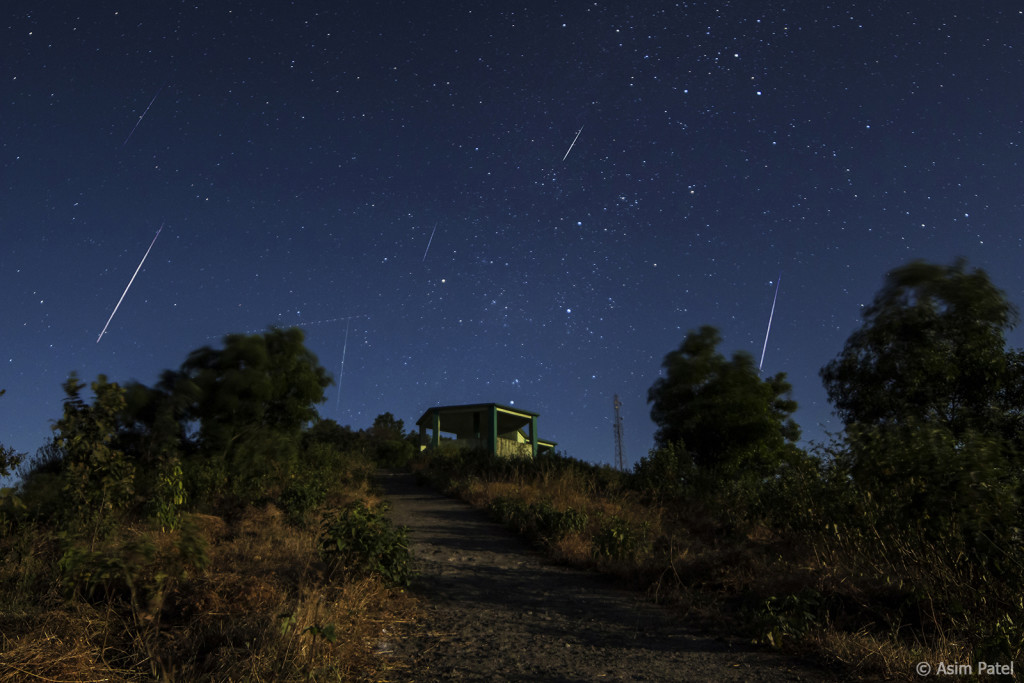
The year 2020 hasn’t been a total disaster, but it’s been close. The heavens, as always, offer respite. And if nothing else, amateur astronomy is becoming popular again for the first time in a long time. This last month of 2020 brings nearly perfect conditions for the Geminid meteor shower, while four bright planets are easily visible in the morning and evening skies. A total solar eclipse comes to South America (and live to the internet) on the 14th. And Jupiter and Saturn make a spectacular close conjunction before Christmas, their closest approach in almost four hundred years. Here’s what to see in the sky this month…
3 December 2020. Just after dark, look eastward to see the waning crescent Moon rising about four degrees from the star Pollux in the constellation Gemini. Nearby Castor, bluer in color, lies above Pollux. Or as I like to remember which is which: Castor is closer to Capella.
8 Dec. Last Quarter Moon, 00:37 UT.

12 Dec. The waning crescent Moon, only 6% illuminated, rises along with Venus in the southeastern sky before dawn. The pair lies just below the 3rd-magnitude stars Zubeneschamli and Zubenelgenubi in the constellation Libra. A pair of binoculars helps pull the Moon and Venus out of the brightening morning sky.
13 Dec. The Geminid meteor shower peaks in the late hours of December 13 and into the early morning of the 14th. The shower coincides with the New Moon this year, making it ideal for seeing the faintest meteors. One of the best and most reliable meteor showers of the year, the Geminids can appear anywhere in the sky and trace their path back to a point in the constellation Gemini near the star Castor. Look after dark for a few Geminids that may enter the atmosphere at a shallow angle and burn slowly across the sky. The shower tends to peak after midnight when several dozen meteors per hour flash across the sky. The Geminids happen on this date each year as the Earth passes through a stream of debris from the asteroid 3200 Phaethon, an Apollo asteroid discovered in 1983.
14 Dec. New Moon, 16:17 UT
14 Dec. A total solar eclipse passes in a narrow band across Chile and Argentina, the second in as many years. This one happens over southern Chile and the Patagonia region of Argentina. More details at this link. Most of South America can also see a partial solar eclipse during this event. No one’s traveling much this year, so if you want to see the eclipse live, the Exploratium in San Francisco is featuring live coverage at this link: https://www.exploratorium.edu/eclipse

16 Dec. Look for a very young crescent Moon a few degrees below the tight pair of Jupiter and Saturn in the southwestern sky after sunset.
21 Dec. The December Solstice arrives at 10:02 UT as winter begins north of the equator and summer begins in the southern half of the world.
21 Dec. First Quarter Moon, 23:41 UT
21 Dec. Jupiter and Saturn reach a spectacular conjunction as they pass within a tenth of a degree of each other. This marks the first conjunction of these planets since 2000 and the closest since 1623 (nineteen years and four days before the birth of Isaac Newton).
Long past their July 2020 oppositions, Jupiter and Saturn (at magnitude -2.0 and +0.6 respectively) are still plenty bright enough to see with the naked eye or in binoculars as darkness falls. It’s also worth the effort to catch this pair, either visually or photographically, in a telescope. But you need to find a good place to view this event: at their closest, the two planets are just 30 degrees east of the Sun less than 10 degrees above the southwestern horizon at dusk. Jupiter and Saturn lie within one degree of each other from December 12-29, which gives you plenty of opportunity to witness this rare planetary meetup in the northern midwinter (and southern midsummer) sky.
23 Dec. The waxing gibbous Moon lies about three finger-widths from Mars in the evening sky. The planet is about 14” across, just over half its size at its October 2020 opposition. It still shines brighter than most stars throughout the month in the constellation Pisces.
26 Dec. The growing gibbous Moon lies about halfway between the Pleiades and Hyades star clusters in the constellation Taurus.
30 Dec. Full Moon, 03:28 UT